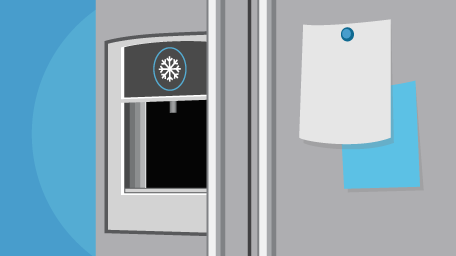
How to Fix a Frigidaire Freezer not Freezing
A Frigidaire freezer not freezing is most often caused by dirty condenser coils, a worn-down gasket, or a faulty thermostat, which result in higher temperatures inside the refrigerator and inadequate airflow. In this article, we'll explore these common issues, as well as several others. It's no secret that a malfunctioning freezer can quickly disrupt your daily routines and jeopardize the preservation of all your food. By understanding the causes of the problem and using the simple troubleshooting techniques laid out here you can swiftly restore your Frigidaire freezer to optimal performance, and ensure your frozen goods remain as fresh as ever.
Dirty Condenser Coils
The condenser coils play an important role in your freezer by releasing heat from the appliance into the surrounding air. If the condenser coils are dirty or covered in dust, they will be unable to disperse this heat effectively, leading to higher temperatures inside your freezer. It is important to regularly clean the condenser coils to ensure that they continue to run efficiently.
How to Clean the Condenser Coils to Fix a Frigidaire Freezer
- Before starting any repairs or maintenance, unplug the freezer to ensure your safety.
- If the coils are located on the back of the freezer, you may need to pull the freezer away from the wall for better access.
- For freezers with coils on the back, they are usually visible once you remove the back panel. If the coils are underneath, you might need to remove a grille or kick plate to access them.
- Use a soft brush, such as a refrigerator coil brush to gently remove the dust and debris from the coils.
- If there is still any remaining dirt, you can use a vacuum cleaner with a brush attachment to carefully suck away the dirt. Ensure the vacuum is set on a low suction setting to avoid damaging the appliance.
- Once the coils are clean and you've checked for any other issues, reassemble the freezer by putting back the panels, grille, or kick plate.
- Plug the freezer back in or turn on the power source.
- Allow the freezer some time to cool down, and then check that the temperature is now at the desired level.
Faulty Door Gasket
The door gasket is an airtight seal that runs along the perimeter of the freezer door. It prevents cold air from escaping while keeping warm air from entering. A faulty door gasket will result in temperature fluctuations and inadequate cooling. If the door gasket is torn or no longer sticking to the door, you will need to replace the door gasket to restore your Frigidaire freezer.
How to Replace the Door Gasket to Fix a Frigidaire Freezer
- Open the freezer door and carefully peel back the old gasket from the edge of the door.
- Wipe the area around the door with a soft cloth or sponge and mild soapy water to remove any dirt or residue.
- Align the new gasket along the edge of the door, making sure it matches the orientation of the old one.
- Press the gasket firmly into place to ensure a tight seal.
- Close the freezer door and check for any gaps or areas where the gasket may not be sealing properly, and adjust as needed.
Temperature Control Thermostat
The thermostat regulates the temperature inside the freezer by sending signals to the compressor about when to start and stop cooling. If the thermostat is malfunctioning, it may not signal the compressor to start when necessary, leading to inadequate cooling. You will need to inspect the thermostat for signs of damage or test it for continuity. If it has failed, you will need to replace the thermostat to restore your freezer. You can usually locate it inside the freezer compartment, near the top, or on the side.
How to Test the Thermostat with a Multimeter
- Disconnect the freezer from the power outlet before beginning.
- Remove any food items/containers and shelves to ensure you have unobstructed access to the thermometer.
- Locate the thermostat and if it has a cover, carefully remove it.
- Inspect the thermostat for signs of damage. If any are present, it will need to be replaced. If not, test the thermostat for continuity.
- Take a picture or note down how the thermostat wires are routed and connected.
- Gently disconnect the wires.
- Turn on your multimeter and set it to the "Ohms" setting.
- Touch the multimeter probes to the terminals on the thermostat. If there is no continuity, then it is likely faulty and needs replacement.
How to Replace the Thermostat to Fix a Frigidaire Freezer
- With the wires already disconnected, remove the thermostat from its mounting bracket.
- Place the new thermostat into the mounting bracket in the same position as the old one and secure it in place with the appropriate hardware.
- Reconnect the wires to the new thermostat and refer to your picture or notes to ensure they are correctly positioned.
- Place and secure the thermostat cover.
- Put back any shelves or storage bins you removed earlier.
- Reconnect the freezer to the power outlet.
- Set the temperature to the desired level and monitor the freezer to ensure it is cooling properly.
Start Relay
The start relay is a small rectangular or cylindrical component on the side of the compressor. It boosts electrical power to the compressor to allow it to start running. A faulty start relay can prevent the compressor from starting, leading to cooling issues. If the start relay is malfunctioning you may hear unusual clicking sounds coming from the compressor area, or notice frequent cycling of the compressor without proper cooling. Inspect the start relay for damage and test it for continuity. If it is faulty, replace the start relay to restore your Frigidaire freezer.
How to Test the Start Relay with a Multimeter
- Disconnect the freezer from the power outlet for your safety.
- Remove the access panel covering the compressor and start relay.
- Locate the start relay on the side of the compressor and take a picture of how the wires are routed.
- Disconnect the wire harness that connects the start relay to the compressor.
- Refer to your user manual or the wiring diagram to correctly identify which terminals to test.
- Turn on your multimeter and set it to the "Ohms" setting.
- Touch the multimeter probes to the appropriate terminals and check for continuity.
- If the start relay is defective, replace it using the instructions below.
How to Replace the Start Relay to Fix a Frigidaire Freezer
- Remove the mounting hardware that is holding the start relay to the compressor.
- Discard the old relay and position the new one inside the appliance.
- Refer to your image from earlier and connect the wire harness to the new relay.
- Secure the new start relay in place using clips or screws.
- Reattach the access panel and secure it in place.
- Plug the freezer back into the power source.
- Allow the freezer some time to cool and confirm that the compressor is once again running smoothly.
Condenser Fan Motor
The condenser fan motor blows air over the condenser coils, helping to release the heat absorbed from the interior of the freezer. The condenser fan helps cool the refrigerant, and if it's not working, then the freezer may not freeze. Check for any obstructions that might be preventing the fan from turning. If the fan motor is faulty, use our model search feature to find the right replacement condenser fan motor.
How to Replace the Condenser Fan Motor to Fix a Frigidaire Freezer
- Disconnect the freezer from the power source.
- Locate the condenser fan motor. It is typically situated near the compressor at the back of the freezer.
- Using a screwdriver or appropriate tool, remove the back panel covering the condenser fan motor.
- Identify the wires connected to the condenser fan motor. Take note of their positions or take a picture for reference.
- Carefully disconnect the wires from the motor.
- Locate and remove the mounting screws that secure the condenser fan motor to the freezer.
- If the fan blade is attached to the motor, carefully detach it. This is often done by removing a retaining nut or clip.
- Place the new condenser fan motor in the same position as the old one and reattach the fan blade if necessary.
- Use the mounting screws to secure the new motor in place.
- Reconnect the wires to the corresponding terminals on the new motor. Refer to your earlier notes or picture for guidance.
- Put the back panel back in its place and secure it with screws.
- Plug the freezer back into the power source.
- Turn on the freezer and check that the new condenser fan motor operates smoothly and that the freezer starts cooling properly.
Evaporator Fan Motor
The evaporator fan circulates air over the evaporator coils, which causes the refrigerant to absorb heat from the freezer. This process is essential for cooling the interior of the freezer and keeping all your food items at the right temperature. If it fails, the freezer may not cool or freeze properly. Use our model search feature to find the right replacement evaporator fan motor for your freezer.
How to Replace the Evaporator Fan Motor to Fix a Frigidaire Freezer
- Disconnect the freezer from the power outlet.
- Open the freezer door and remove any food items or shelves. The evaporator fan motor is usually located in the freezer compartment, either behind the back panel or near the evaporator coils. .
- Unscrew the screws securing the back panel using a screwdriver.
- Locate the evaporator fan motor and take an image of how the wires are connected for installation later.
- Disconnect the wiring harness. Use needle-nose pliers if necessary.
- Remove any screws or clips securing the fan motor in place.
- Gently pull out the old evaporator fan motor from its housing.
- Place the new evaporator fan motor into the housing. Secure the motor with the screws or clips you removed earlier.
- Connect the wiring harness to the new evaporator fan motor using your image for reference.
- Put the back panel back in place and secure it with the screws. Reinstall any shelves that were removed.
- Plug the freezer back in.
- Allow the freezer some time to cool, and then check if the new evaporator fan motor is functioning properly.
Control Board
The control board communicates with various freezer components and sensors to control the functions of the freezer. If it malfunctions, it may lead to difficulties regulating the temperature or controlling the fans and motors, resulting in cooling problems. Check for visible signs of damage on the control board. If any are present, you will need to replace the control board.
How to Replace the Control Board to Fix a Frigidaire Freezer
- Unplug the freezer from the power source.
- Refer to your user manual to locate the control board. It is typically found at the bottom of your appliance, towards either the front or rear end.
- Remove any covers/panels that conceal the control board.
- Before disconnecting any wires, take a picture of the current wiring setup. This will help you reconnect everything correctly later.
- Gently disconnect the wires from the control board.
- Unscrew the old control board from its mounting brackets, and discard it.
- Align the new control board with the mounting brackets.
- Secure the board in place using the screws you removed earlier.
- Refer to the picture you took earlier to reconnect the wires to the corresponding terminals on the new control board.
- Reattach any covers or panels you removed to access the control board and secure them back in place.
- Plug the freezer back into the power source.
Faulty Compressor
The compressor is the heart of the cooling system in your freezer. If the compressor is not functioning, the freezer won't cool. The compressor may fail due to electrical issues, a seized motor, or a failure in the internal components. If the compressor is making unusual noises, not running, or excessively hot, it will need professional repair or replacement. This is a critical component that involves a complex repair. It is recommended to call a qualified technician to address any compressor problems.
As you've seen a Frigidaire freezer that's running but not freezing may be the result of various issues in the appliance. From worn-down door gaskets to faulty control boards, understanding the root causes is essential for effective troubleshooting. Regular maintenance, including cleaning the coils, checking the seals, and monitoring temperature settings, is an important part of preventing future issues. By staying proactive in maintaining your Frigidaire freezer, you can extend the lifespan of your freezer and enjoy consistent and reliable freezing capabilities.




























